Healthcare Report: Capitalist Care, HIT, and Dementia Analysis
VerifiedAdded on 2022/09/18
|8
|1534
|22
Report
AI Summary
This report delves into the interconnected concepts of capitalist care, health information technology (HIT), and dementia, primarily within the context of the UK's National Health Service (NHS). The analysis begins with a discussion of capitalist care, contrasting it with the NHS's current state-funded model and exploring the potential impact of government reforms that may push the NHS towards a more market-driven system, similar to the US healthcare model. The report then examines the role of HIT in healthcare, focusing on its use in data storage, sharing, and decision-making, and its impact on patients with dementia. The discussion also addresses the importance of information accessibility for individuals with dementia, highlighting the need to understand their needs and preferences. Finally, the report touches upon the overlapping roles of community matrons and hospital coordinators in patient care, along with the potential for information misuse and the importance of person-centered approaches in dementia care. The report concludes that due to recent coalition reforms of the UK government, there is a risk of the NHS becoming a capitalist health care setting.
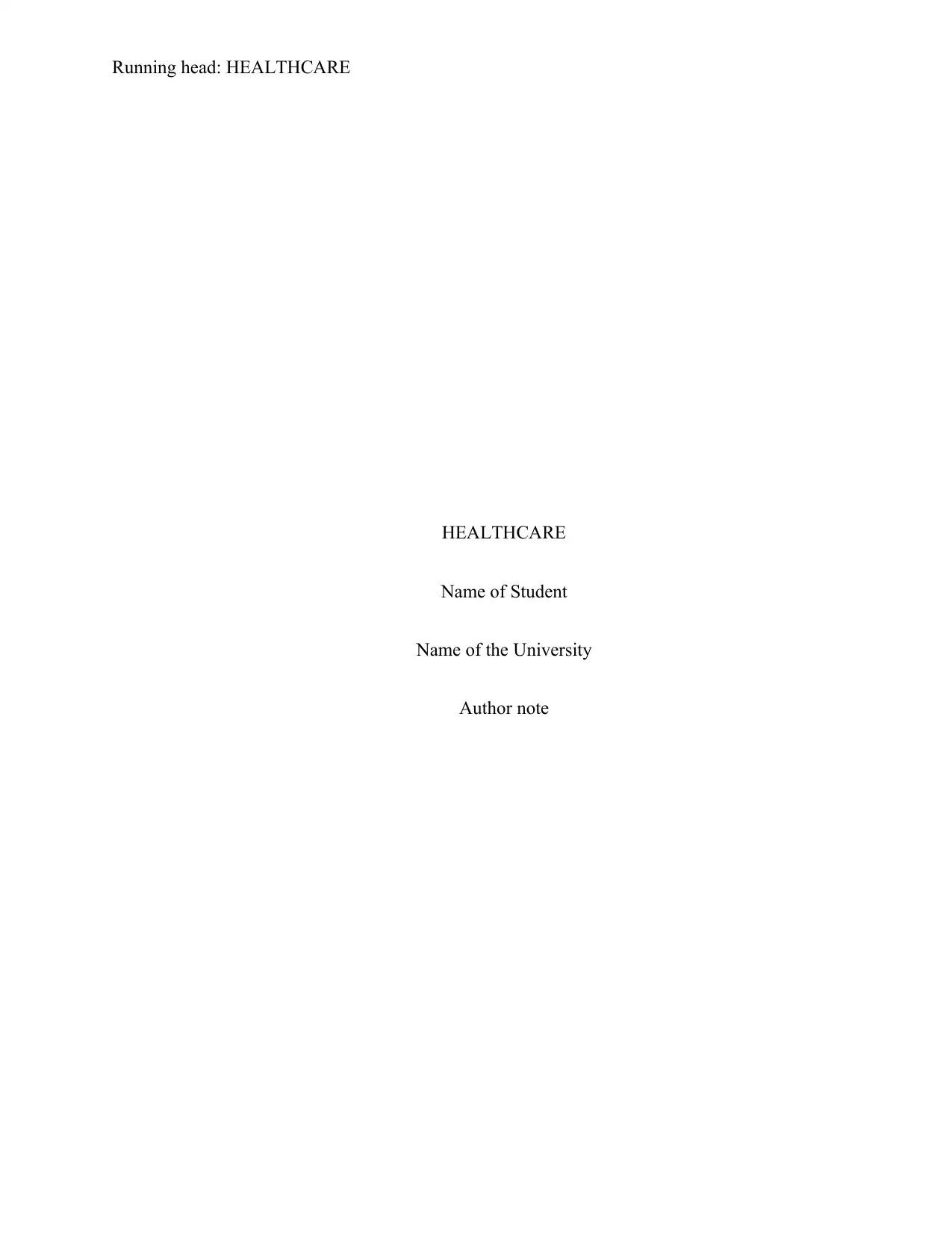
Running head: HEALTHCARE
HEALTHCARE
Name of Student
Name of the University
Author note
HEALTHCARE
Name of Student
Name of the University
Author note
Paraphrase This Document
Need a fresh take? Get an instant paraphrase of this document with our AI Paraphraser
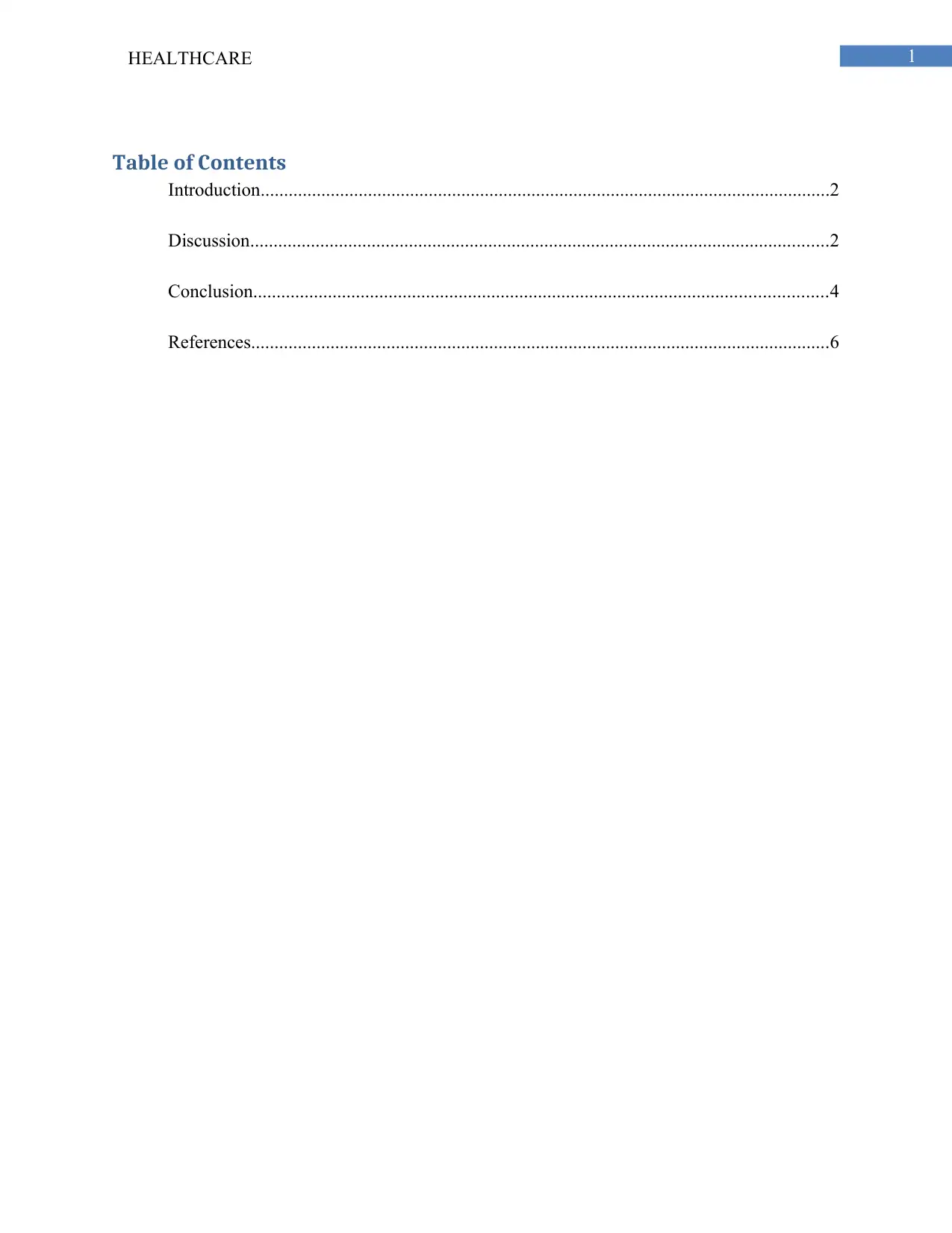
1HEALTHCARE
Table of Contents
Introduction..........................................................................................................................2
Discussion............................................................................................................................2
Conclusion...........................................................................................................................4
References............................................................................................................................6
Table of Contents
Introduction..........................................................................................................................2
Discussion............................................................................................................................2
Conclusion...........................................................................................................................4
References............................................................................................................................6

2HEALTHCARE
Introduction
Capitalist care refers to a competitive system of health care that is more privately run.
Therefore many nations are trying to transform their traditional health care system into a
capitalist one (Lehoux et al. 2016). Health information technology includes the processing of
information with the help of both software and hardware and that majorly helps in healthcare
related data storage, sharing and revival and use for the purpose of making informed decisions
and communication. Dementia on the other hand refers to a syndrome that causes deterioration
of thinking, memory, performance ability and behavior (Yen et al. 2017). It majorly affects the
health of the older people. The main aim of the paper is to discuss about the concepts of
capitalist care, Health Information Technology or HIT and dementia. The paper will discuss
about the three concepts of- capitalist care, health information technology and dementia based on
the abstracts.
Discussion
According to Hart, a gift economy is one in which care us free on delivery, there are no
priorities that dictate the market, and lack of subordination of the organizations to
industrialization based in business lines. This definition given by Hart is completely contrasting a
capitalist economy. Similarly, there can be capitalistic care setting which are competitive and
privately run like that in the US health care. The government’s decision of coalition may move
the NHS towards a more capitalistic care setting like that in the US health care setting. Many
authors like Hart believed that though the health care of NHS is not a gift economy any more, the
NHS has still not approached theprofit driven, market-centred health care model that is presently
being used in the US health care. The NHS is still a state funded service and not a capitalist care
Introduction
Capitalist care refers to a competitive system of health care that is more privately run.
Therefore many nations are trying to transform their traditional health care system into a
capitalist one (Lehoux et al. 2016). Health information technology includes the processing of
information with the help of both software and hardware and that majorly helps in healthcare
related data storage, sharing and revival and use for the purpose of making informed decisions
and communication. Dementia on the other hand refers to a syndrome that causes deterioration
of thinking, memory, performance ability and behavior (Yen et al. 2017). It majorly affects the
health of the older people. The main aim of the paper is to discuss about the concepts of
capitalist care, Health Information Technology or HIT and dementia. The paper will discuss
about the three concepts of- capitalist care, health information technology and dementia based on
the abstracts.
Discussion
According to Hart, a gift economy is one in which care us free on delivery, there are no
priorities that dictate the market, and lack of subordination of the organizations to
industrialization based in business lines. This definition given by Hart is completely contrasting a
capitalist economy. Similarly, there can be capitalistic care setting which are competitive and
privately run like that in the US health care. The government’s decision of coalition may move
the NHS towards a more capitalistic care setting like that in the US health care setting. Many
authors like Hart believed that though the health care of NHS is not a gift economy any more, the
NHS has still not approached theprofit driven, market-centred health care model that is presently
being used in the US health care. The NHS is still a state funded service and not a capitalist care
⊘ This is a preview!⊘
Do you want full access?
Subscribe today to unlock all pages.

Trusted by 1+ million students worldwide
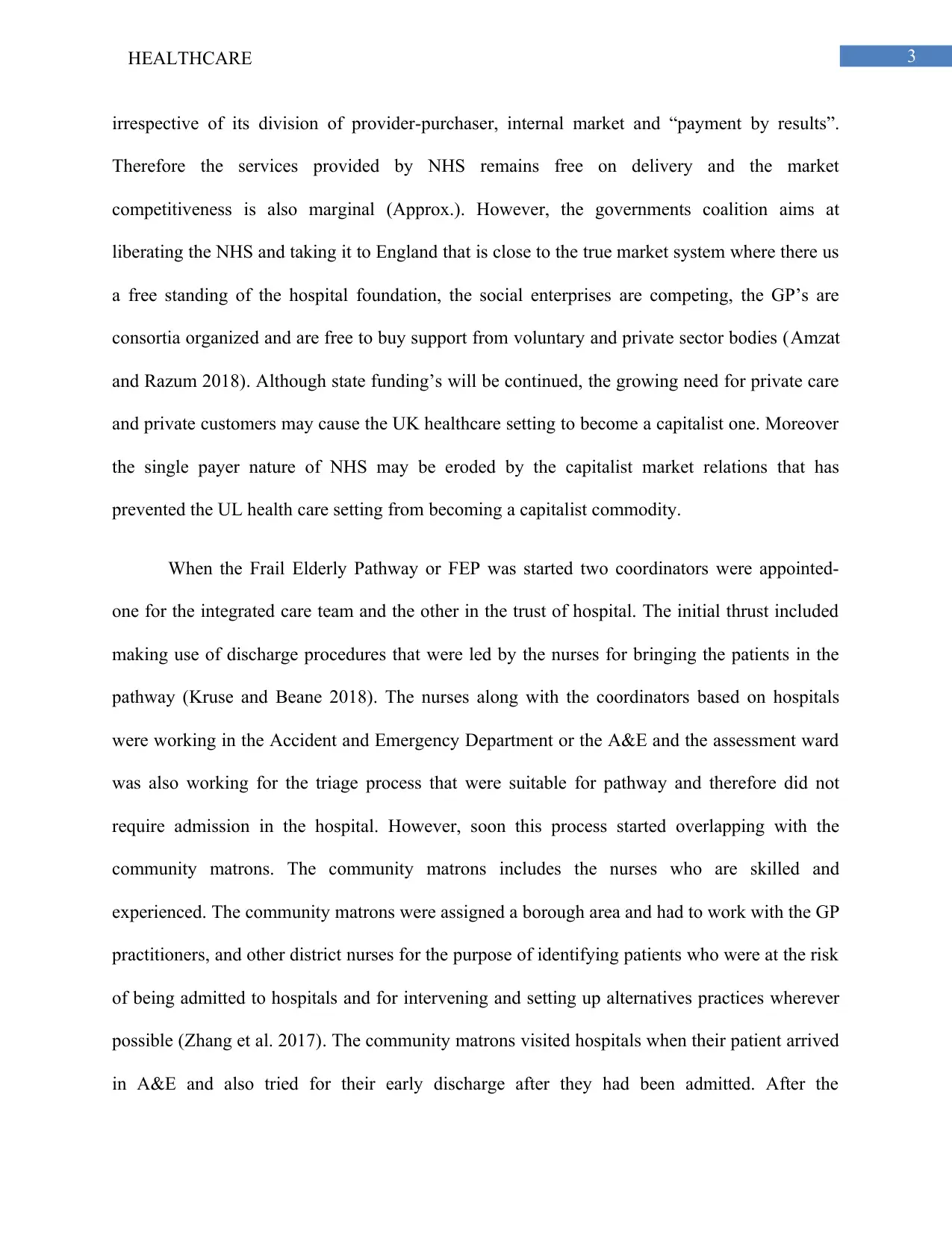
3HEALTHCARE
irrespective of its division of provider-purchaser, internal market and “payment by results”.
Therefore the services provided by NHS remains free on delivery and the market
competitiveness is also marginal (Approx.). However, the governments coalition aims at
liberating the NHS and taking it to England that is close to the true market system where there us
a free standing of the hospital foundation, the social enterprises are competing, the GP’s are
consortia organized and are free to buy support from voluntary and private sector bodies (Amzat
and Razum 2018). Although state funding’s will be continued, the growing need for private care
and private customers may cause the UK healthcare setting to become a capitalist one. Moreover
the single payer nature of NHS may be eroded by the capitalist market relations that has
prevented the UL health care setting from becoming a capitalist commodity.
When the Frail Elderly Pathway or FEP was started two coordinators were appointed-
one for the integrated care team and the other in the trust of hospital. The initial thrust included
making use of discharge procedures that were led by the nurses for bringing the patients in the
pathway (Kruse and Beane 2018). The nurses along with the coordinators based on hospitals
were working in the Accident and Emergency Department or the A&E and the assessment ward
was also working for the triage process that were suitable for pathway and therefore did not
require admission in the hospital. However, soon this process started overlapping with the
community matrons. The community matrons includes the nurses who are skilled and
experienced. The community matrons were assigned a borough area and had to work with the GP
practitioners, and other district nurses for the purpose of identifying patients who were at the risk
of being admitted to hospitals and for intervening and setting up alternatives practices wherever
possible (Zhang et al. 2017). The community matrons visited hospitals when their patient arrived
in A&E and also tried for their early discharge after they had been admitted. After the
irrespective of its division of provider-purchaser, internal market and “payment by results”.
Therefore the services provided by NHS remains free on delivery and the market
competitiveness is also marginal (Approx.). However, the governments coalition aims at
liberating the NHS and taking it to England that is close to the true market system where there us
a free standing of the hospital foundation, the social enterprises are competing, the GP’s are
consortia organized and are free to buy support from voluntary and private sector bodies (Amzat
and Razum 2018). Although state funding’s will be continued, the growing need for private care
and private customers may cause the UK healthcare setting to become a capitalist one. Moreover
the single payer nature of NHS may be eroded by the capitalist market relations that has
prevented the UL health care setting from becoming a capitalist commodity.
When the Frail Elderly Pathway or FEP was started two coordinators were appointed-
one for the integrated care team and the other in the trust of hospital. The initial thrust included
making use of discharge procedures that were led by the nurses for bringing the patients in the
pathway (Kruse and Beane 2018). The nurses along with the coordinators based on hospitals
were working in the Accident and Emergency Department or the A&E and the assessment ward
was also working for the triage process that were suitable for pathway and therefore did not
require admission in the hospital. However, soon this process started overlapping with the
community matrons. The community matrons includes the nurses who are skilled and
experienced. The community matrons were assigned a borough area and had to work with the GP
practitioners, and other district nurses for the purpose of identifying patients who were at the risk
of being admitted to hospitals and for intervening and setting up alternatives practices wherever
possible (Zhang et al. 2017). The community matrons visited hospitals when their patient arrived
in A&E and also tried for their early discharge after they had been admitted. After the
Paraphrase This Document
Need a fresh take? Get an instant paraphrase of this document with our AI Paraphraser
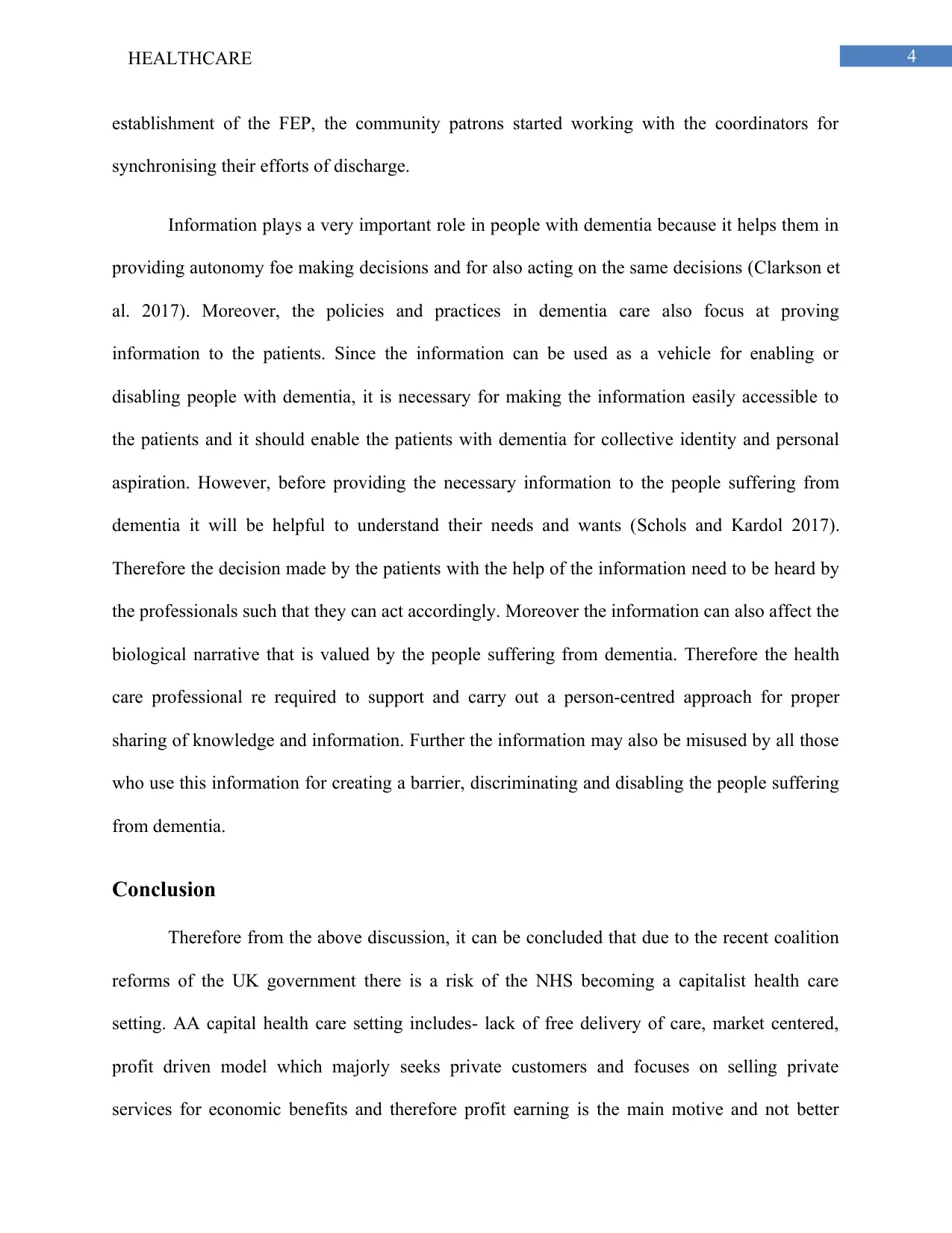
4HEALTHCARE
establishment of the FEP, the community patrons started working with the coordinators for
synchronising their efforts of discharge.
Information plays a very important role in people with dementia because it helps them in
providing autonomy foe making decisions and for also acting on the same decisions (Clarkson et
al. 2017). Moreover, the policies and practices in dementia care also focus at proving
information to the patients. Since the information can be used as a vehicle for enabling or
disabling people with dementia, it is necessary for making the information easily accessible to
the patients and it should enable the patients with dementia for collective identity and personal
aspiration. However, before providing the necessary information to the people suffering from
dementia it will be helpful to understand their needs and wants (Schols and Kardol 2017).
Therefore the decision made by the patients with the help of the information need to be heard by
the professionals such that they can act accordingly. Moreover the information can also affect the
biological narrative that is valued by the people suffering from dementia. Therefore the health
care professional re required to support and carry out a person-centred approach for proper
sharing of knowledge and information. Further the information may also be misused by all those
who use this information for creating a barrier, discriminating and disabling the people suffering
from dementia.
Conclusion
Therefore from the above discussion, it can be concluded that due to the recent coalition
reforms of the UK government there is a risk of the NHS becoming a capitalist health care
setting. AA capital health care setting includes- lack of free delivery of care, market centered,
profit driven model which majorly seeks private customers and focuses on selling private
services for economic benefits and therefore profit earning is the main motive and not better
establishment of the FEP, the community patrons started working with the coordinators for
synchronising their efforts of discharge.
Information plays a very important role in people with dementia because it helps them in
providing autonomy foe making decisions and for also acting on the same decisions (Clarkson et
al. 2017). Moreover, the policies and practices in dementia care also focus at proving
information to the patients. Since the information can be used as a vehicle for enabling or
disabling people with dementia, it is necessary for making the information easily accessible to
the patients and it should enable the patients with dementia for collective identity and personal
aspiration. However, before providing the necessary information to the people suffering from
dementia it will be helpful to understand their needs and wants (Schols and Kardol 2017).
Therefore the decision made by the patients with the help of the information need to be heard by
the professionals such that they can act accordingly. Moreover the information can also affect the
biological narrative that is valued by the people suffering from dementia. Therefore the health
care professional re required to support and carry out a person-centred approach for proper
sharing of knowledge and information. Further the information may also be misused by all those
who use this information for creating a barrier, discriminating and disabling the people suffering
from dementia.
Conclusion
Therefore from the above discussion, it can be concluded that due to the recent coalition
reforms of the UK government there is a risk of the NHS becoming a capitalist health care
setting. AA capital health care setting includes- lack of free delivery of care, market centered,
profit driven model which majorly seeks private customers and focuses on selling private
services for economic benefits and therefore profit earning is the main motive and not better
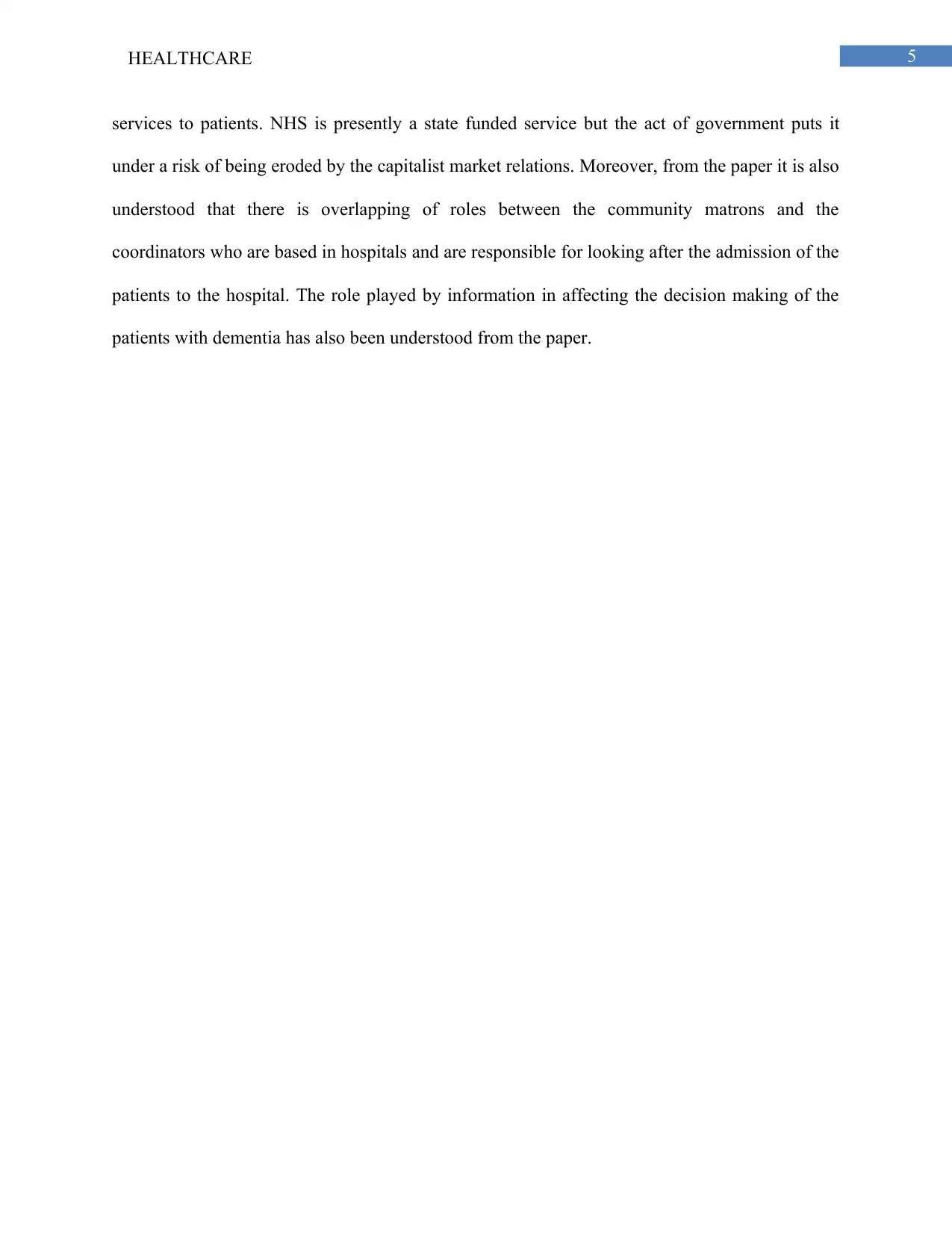
5HEALTHCARE
services to patients. NHS is presently a state funded service but the act of government puts it
under a risk of being eroded by the capitalist market relations. Moreover, from the paper it is also
understood that there is overlapping of roles between the community matrons and the
coordinators who are based in hospitals and are responsible for looking after the admission of the
patients to the hospital. The role played by information in affecting the decision making of the
patients with dementia has also been understood from the paper.
services to patients. NHS is presently a state funded service but the act of government puts it
under a risk of being eroded by the capitalist market relations. Moreover, from the paper it is also
understood that there is overlapping of roles between the community matrons and the
coordinators who are based in hospitals and are responsible for looking after the admission of the
patients to the hospital. The role played by information in affecting the decision making of the
patients with dementia has also been understood from the paper.
⊘ This is a preview!⊘
Do you want full access?
Subscribe today to unlock all pages.

Trusted by 1+ million students worldwide

6HEALTHCARE
References
Amzat, J. and Razum, O., 2018. Healthcare Delivery Systems. In Towards a Sociology of Health
Discourse in Africa (pp. 35-49). Springer, Cham.
Clarkson, P., Davies, L., Jasper, R., Loynes, N., Challis, D., in Dementia, H.S. and Group, P.M.,
2017. A systematic review of the economic evidence for home support interventions in
dementia. Value in Health, 20(8), pp.1198-1209.
Kruse, C.S. and Beane, A., 2018. Health information technology continues to show positive
effect on medical outcomes: systematic review. Journal of medical Internet research, 20(2),
p.e41.
Lehoux, P., Miller, F.A., Daudelin, G. and Urbach, D.R., 2016. How venture capitalists decide
which new medical technologies come to exist. Science and Public Policy, 43(3), pp.375-385.
Livingston, G., Sommerlad, A., Orgeta, V., Costafreda, S.G., Huntley, J., Ames, D., Ballard, C.,
Banerjee, S., Burns, A., Cohen-Mansfield, J. and Cooper, C., 2017. Dementia prevention,
intervention, and care. The Lancet, 390(10113), pp.2673-2734.
Schols, J. and Kardol, T., 2017. Dementia Care in Nursing Homes Requires a Multidisciplinary
Approach. In Dementia in Nursing Homes (pp. 203-217). Springer, Cham.
Yen, P.Y., McAlearney, A.S., Sieck, C.J., Hefner, J.L. and Huerta, T.R., 2017. Health
information technology (HIT) adaptation: refocusing on the journey to successful HIT
implementation. JMIR medical informatics, 5(3), p.e28.
References
Amzat, J. and Razum, O., 2018. Healthcare Delivery Systems. In Towards a Sociology of Health
Discourse in Africa (pp. 35-49). Springer, Cham.
Clarkson, P., Davies, L., Jasper, R., Loynes, N., Challis, D., in Dementia, H.S. and Group, P.M.,
2017. A systematic review of the economic evidence for home support interventions in
dementia. Value in Health, 20(8), pp.1198-1209.
Kruse, C.S. and Beane, A., 2018. Health information technology continues to show positive
effect on medical outcomes: systematic review. Journal of medical Internet research, 20(2),
p.e41.
Lehoux, P., Miller, F.A., Daudelin, G. and Urbach, D.R., 2016. How venture capitalists decide
which new medical technologies come to exist. Science and Public Policy, 43(3), pp.375-385.
Livingston, G., Sommerlad, A., Orgeta, V., Costafreda, S.G., Huntley, J., Ames, D., Ballard, C.,
Banerjee, S., Burns, A., Cohen-Mansfield, J. and Cooper, C., 2017. Dementia prevention,
intervention, and care. The Lancet, 390(10113), pp.2673-2734.
Schols, J. and Kardol, T., 2017. Dementia Care in Nursing Homes Requires a Multidisciplinary
Approach. In Dementia in Nursing Homes (pp. 203-217). Springer, Cham.
Yen, P.Y., McAlearney, A.S., Sieck, C.J., Hefner, J.L. and Huerta, T.R., 2017. Health
information technology (HIT) adaptation: refocusing on the journey to successful HIT
implementation. JMIR medical informatics, 5(3), p.e28.
Paraphrase This Document
Need a fresh take? Get an instant paraphrase of this document with our AI Paraphraser
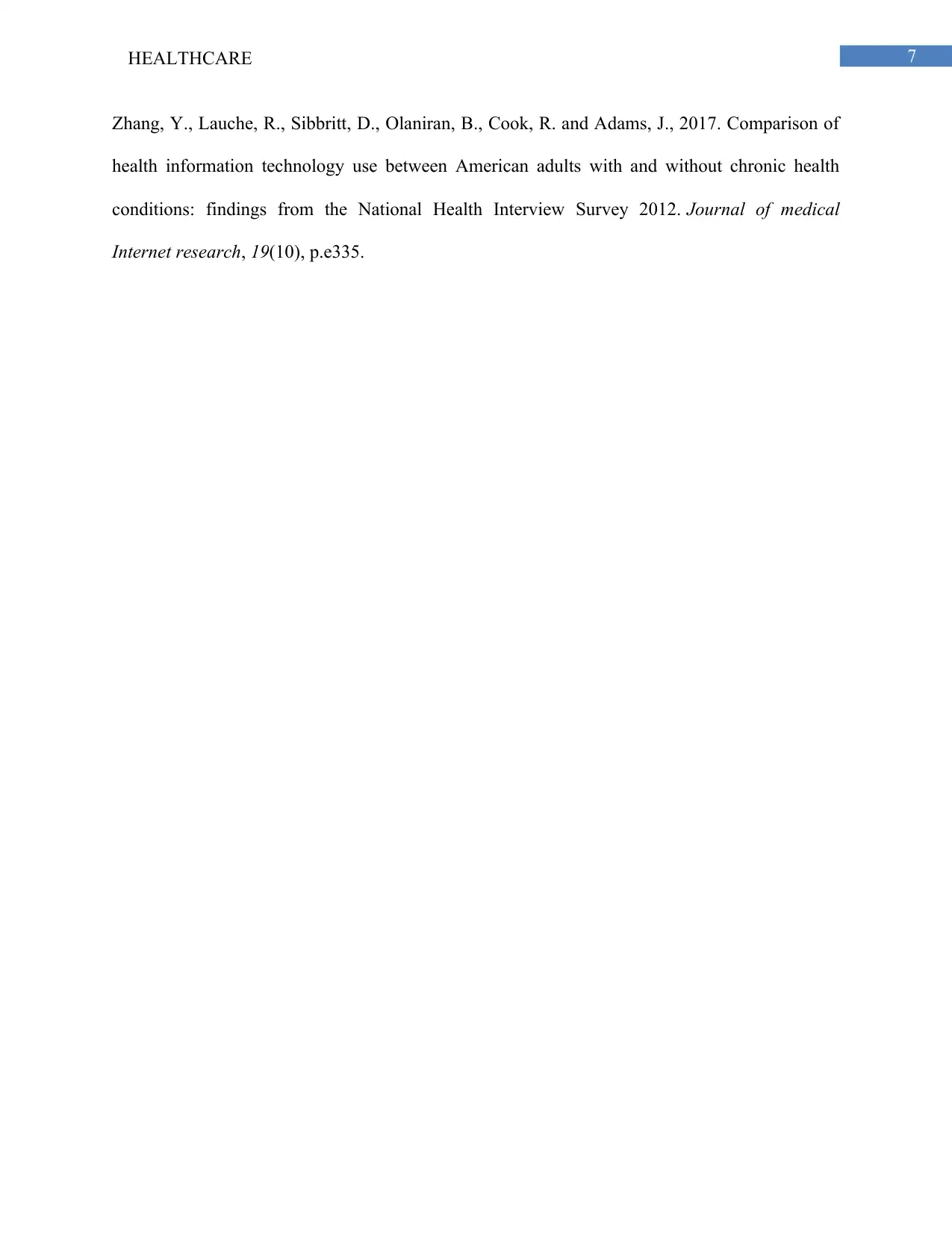
7HEALTHCARE
Zhang, Y., Lauche, R., Sibbritt, D., Olaniran, B., Cook, R. and Adams, J., 2017. Comparison of
health information technology use between American adults with and without chronic health
conditions: findings from the National Health Interview Survey 2012. Journal of medical
Internet research, 19(10), p.e335.
Zhang, Y., Lauche, R., Sibbritt, D., Olaniran, B., Cook, R. and Adams, J., 2017. Comparison of
health information technology use between American adults with and without chronic health
conditions: findings from the National Health Interview Survey 2012. Journal of medical
Internet research, 19(10), p.e335.
1 out of 8
Related Documents
Your All-in-One AI-Powered Toolkit for Academic Success.
+13062052269
info@desklib.com
Available 24*7 on WhatsApp / Email
![[object Object]](/_next/static/media/star-bottom.7253800d.svg)
Unlock your academic potential
Copyright © 2020–2025 A2Z Services. All Rights Reserved. Developed and managed by ZUCOL.




